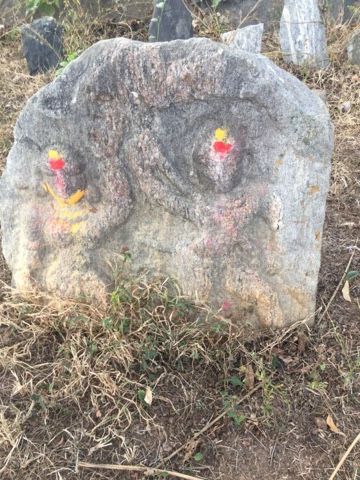Kunigal is best known for the stud farms started by Hyder Ali , which later came into the possession of The Mysore Wodeyars . In modern times , owning a stud farm in Kunigal has been an indicator of the worthiness of The Rich and Famous .
Other than the horses, it is the Dodda Kere ( The Big Tank ) , or Moodal Kere , that is Kunigal's USP .
Extensive , brimming with water drained by three hill streams Nalini , Nagini and Kamala that originate in Sivaganga , banks dotted with ancient watergate pavilions (Neer bagilu) , aged trees and shrines , the Dodda Kere is not only very picturesque but also a very serene and soothing place to unwind in.
The signboard ontbe temple says:
Nartanapuri Someshwara Swami Devalaya
Nartanapuri seems to be the old name of Kunigal . But in inscriptionsfround around the place , the town isnamed as Kuningil .in early 9th Century, the region seems to have been governed by a minor Chalukyan prince named Vimaladitya , nephew of a Rahtrakuta viceroy , Chakiraja , who administered for the Gangas .
The large tank , 14 miles round , the centerpiece of the town was , according to legend built by one Nriga Chakravarthy as thanksgiving for having been cured of leprosy by the waters of river Nagini .
On the bank of the kere stands the very old Someshwara temple believed to have been built when the original Kunigal Fort was built by a Ganga governor, in 785 CE .A later , stronger Fort was built by Vira Kambala Raya in 1290 which was extented and fortified by the Magadi Chiefs who took possession of the place eventually. Remnants of the Fort can still be seen .
Someshwara , the main temple houses a swayambu lingam and is the oldest shrine in the complex. The main wing is flanked bysmal,er cella to the goddesses, Parvathi, Saraswathi and Mahishamardini.
Someshwara was later surrounded by Chandramouleshwara and Panchalingeshwara shrines during 16 th -17th Centuries . The former looks not too old , while the latter is just a corridor with five lingams in individual niches , guarded by a lone , forlon looking Nandi of considerably older vintage.
The Hoysalas , who briefly held the fort and built two other temples some distance away , seem to have renovated and mantained Someshwara temple , as evidenced by a couple of idols contributed by them, including the Saraswathi - the only one we could see, as the temple was locked . Reportedly , there is a unique Suryanarayana image with navagrahas in its prabhavali , placed in front if the lingam , but we missed it .
In a small shrine behind the main , sits a decidedly ancient Chandikeshwara, looking comfortable in his stone seat .
The front porch shows the style patronised by Chozha vassals and the Magadi warlords . The latter eventually took control of Kunigal . The bas relief panels on the pillars show robust picturisations of wrestlers , hunters ,horsemen and the like .
Though supported by buttresses , the Someshwara shrine is sinking , quite visibly . The locals have put in a concerted effort to keep it standing and in good repair .
The porch is in good shape and endearingly , painted gold by the simple locals for whom Faith and respect to the Gods score above any urbanite sense of aesthetics.
A painted signage on the temple wall says :
" The Moodal kere and Someshwara temple are our Valuable property .
To take good care of them is our Duty "
God will bless them .
The numerous Naga stones and a couple of hero memorial slabs , scattered all around this place add a sense of drama to this very lovely landscape .
There is a folklore about 7 Jogis from Himalayas having come here and found treasure on the bank of this tank , under a large tree. But to retrieve it , they had to kill the SevenHeaded Naga that guarded it .
Looking at the profusion of NagaStones , erected for earning merit and as "pariharas" ( expiation of sins) , one wonders if the resident Naga spirits are still extracting their dues to compensate for that original sin !
The beauty of Kunigal lake is immortalised in a beloved Kannada Janapada Geethe ( Folk Song ) that starts with the line :
" Moodal Kunigal Kere nodorigindai bhoga , moodi barthaney chandirama ...."
meaning
" its the lucky ones who get to see the Lake which the Moon too visits to enjoy ..."
We sure were lucky to enjoy the vista !










No comments:
Post a Comment